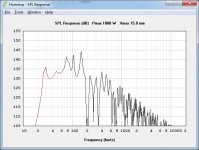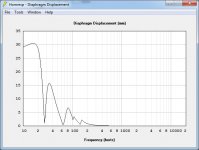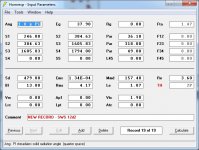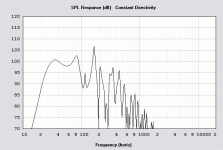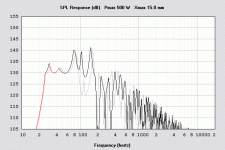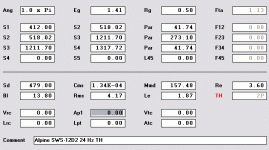Right you are. I somehow wasn't thinking about it in my head correctly as I was modeling it. That adustability made sense when I was doing Offset driver calculations and when I went back to Tapped Horn, I forget to stop doing it.
Here is roughly how the tapped horn was going to be setup:

The red and green different lines show how I am able to vary S3 - S4 as well as L3-L4 (depending on how far I bring the mouth into the house). Construction will be complicated and there will likely be a gasket of some sort connecting the rectangular section to the section that runs through the house. I've also now determined that I will be limited to about 2300-2500 sq cm for the combined mouths of S2 and S3.
I'm still working on how to calculate exactly what L3-L4 will be, but it should be between 30 and 55cm.
Thanks for are your help everyone.
Here is roughly how the tapped horn was going to be setup:

The red and green different lines show how I am able to vary S3 - S4 as well as L3-L4 (depending on how far I bring the mouth into the house). Construction will be complicated and there will likely be a gasket of some sort connecting the rectangular section to the section that runs through the house. I've also now determined that I will be limited to about 2300-2500 sq cm for the combined mouths of S2 and S3.
I'm still working on how to calculate exactly what L3-L4 will be, but it should be between 30 and 55cm.
Thanks for are your help everyone.
If this is a permanent installation and the enclosure doesn't need to be perfectly rectangular and it uses part of the house (the wall hole) to complete the horn you can make just about anything work including the throat flare, as Weltersys showed. Most people don't have this flexibility, they just want a rectangular box with little or no wasted space, that's why these points were brought up.
When I look at the Hornresp Schematic Diagram, this does not look quite like a single fold to me.
Agreed, here's the corrected one [shaded] @ ~636.602 L Vs mine @ ~431.632 L and at 500 W. Not much useful SPL gained for 200+ extra liters:
GM
Attachments
Agreed, here's the corrected one [shaded] @ ~636.602 L Vs mine @ ~431.632 L and at 500 W. Not much useful SPL gained for 200+ extra liters:
GM
I didn't get this. What are you referencing here? Are you stating a different kind of horn that is much larger? I believe my Dayton 15" design above is only 362L roughly.
Last edited:
Final few questions on this design:
1) Is the 2.6:1 ratio above reasonable? Since it's a fairly lightweight pro-audio cone, I can go to something lower at the expense of a little more raggedness in the response. (seen below is a revision that lowers this a bit, at the expense of smooth response. 1.89:1)
2) Is an S3 of something like 1.2 * Sd Large enough? When I raised the S2, this was a result that worked well to smooth the response slightly as well as made the box even smaller. The final mouth is still over 2*Sd, yet that segment is quite short. (40cm). (S3=1036cm^2)
Seen below is these changes as well as a few others that help fit my physical dimensions. It has a slight roll off but I'm sure that will be supplemented by room gain. The other problem is the dip at 120hz, though it may be far enough away from the crossover freq not to make a huge difference.



1) Is the 2.6:1 ratio above reasonable? Since it's a fairly lightweight pro-audio cone, I can go to something lower at the expense of a little more raggedness in the response. (seen below is a revision that lowers this a bit, at the expense of smooth response. 1.89:1)
2) Is an S3 of something like 1.2 * Sd Large enough? When I raised the S2, this was a result that worked well to smooth the response slightly as well as made the box even smaller. The final mouth is still over 2*Sd, yet that segment is quite short. (40cm). (S3=1036cm^2)
Seen below is these changes as well as a few others that help fit my physical dimensions. It has a slight roll off but I'm sure that will be supplemented by room gain. The other problem is the dip at 120hz, though it may be far enough away from the crossover freq not to make a huge difference.



When yours is converted to a true single fold with a divider board, like shown in post #21, the net Vb 'grows' between S1, S4 due to this type layout being a parabolic expansion. Open yours in the wizard and click the S2, S3 'manual' to 'auto' and it will convert it to parabolic, which significantly increases net Vb.
That said, I just noticed the big offset between S1, S2 isn’t shown in post #21, so working backward from S2………. I get a 2.2 conic Fta, then converting to Par and using the wizard to get S2 back to ~351 cm^2 equates to ~361.889 L.
Now mine and your sims are much closer with my larger one going a bit lower and extending a little higher to account for its ~70 extra liters.
GM
That said, I just noticed the big offset between S1, S2 isn’t shown in post #21, so working backward from S2………. I get a 2.2 conic Fta, then converting to Par and using the wizard to get S2 back to ~351 cm^2 equates to ~361.889 L.
Now mine and your sims are much closer with my larger one going a bit lower and extending a little higher to account for its ~70 extra liters.
GM
Attachments
Final few questions on this design:[/IMG]
Again, this type layout doesn't fit your simple single fold. The expansion must be linear from S1-S4, i.e. have a parabolic expansion. Your corrected original is fine if it fits in your max dimensions.
When I convert this one by working backward from S2………. I get a 1.3 conic Fta, then converting to Par and using the wizard to get S2 back to ~453 cm^2 equates to ~259.111 L, so won't have as much gain BW as the larger one, but still a viable design.
GM
Attachments
Thanks for the explanation GM. Space isn't really an issue, I came up with that Sim mainly trying to decrease the compression ratio as well as I could. And my design doesn't need to be a perfect 1 fold as I showed in the diagram S4 can be variable and so can l34.
Any thoughts on the compression ratio?
Any thoughts on the compression ratio?
So in two DSL THs? Is that including the Matterhorn?
Both the TH-50 and Matterhorn drivers sure looked like MTX to me, but don't know which ones since they had no labels.
GM
Thanks for the explanation GM. Space isn't really an issue, I came up with that Sim mainly trying to decrease the compression ratio as well as I could. And my design doesn't need to be a perfect 1 fold as I showed in the diagram S4 can be variable and so can l34.
Any thoughts on the compression ratio?
You're welcome!
Understood, but was trying to keep it simple since we got to get the basics right first. 😉
Tom Danley says around 3:1 is the limit in prosound apps, though some of his designs are 1:1, so with no personal experience with THs, I suggest you browse for builds with feedback on performance and see what CR @ S2 was used.
GM
Ok, I was about to pull the trigger but again with my craigslist searches found a pair of Alpine SWS-12D2. With a reasonably higher FS these model better than the 15. Was thinking of just a pair of these. Somewhat more ragged response, but about $60 less in driver cost for me along with more confidence in 2 12" auto cones vs 1 PA 15" cone (for high SPL compression distortion). They extend a fair bit lower as well.
Anyone have preference of these vs the single 15" Dayton? Again they are local and I can pick them up tonight which is a big plus for me. I live in Canada and our dollar is tanking not to mention having to drive across the line to get my US purchases.
Anyone have preference of these vs the single 15" Dayton? Again they are local and I can pick them up tonight which is a big plus for me. I live in Canada and our dollar is tanking not to mention having to drive across the line to get my US purchases.
Attachments
Ask Tundra about his MTX9500 loaded TH's. I think it's the 9500 at least. He may have all 4 completed by now. I forget.
The Dayton Audio PA385S-8 MMS is 172.5 grams, slightly heavier than the B&C 15TBX100 which performs well in high compression TH.Somewhat more ragged response, but about $60 less in driver cost for me along with more confidence in 2 12" auto cones vs 1 PA 15" cone (for high SPL compression distortion). They extend a fair bit lower as well.
Anyone have preference of these vs the single 15" Dayton?
The B&C 12TBX100 has a MMS of 119, it also is a good TH performer.
Do you have an MMS spec for the Alpine SWS-12D2?
The Dayton Audio PA385S-8 MMS is 172.5 grams, slightly heavier than the B&C 15TBX100 which performs well in high compression TH.
The B&C 12TBX100 has a MMS of 119, it also is a good TH performer.
Do you have an MMS spec for the Alpine SWS-12D2?
I don't have it explicitly. Is Mms different than the Mmd that horn response calculates? Shows 157.4
Do you have an MMS spec for the Alpine SWS-12D2?
WinISD Pro calcs 162.4 g. Mms.
GM
Ok, I was about to pull the trigger but again with my craigslist searches found a pair of Alpine SWS-12D2. With a reasonably higher FS these model better than the 15. Was thinking of just a pair of these. Somewhat more ragged response, but about $60 less in driver cost for me along with more confidence in 2 12" auto cones vs 1 PA 15" cone (for high SPL compression distortion). They extend a fair bit lower as well.
Anyone have preference of these vs the single 15" Dayton? Again they are local and I can pick them up tonight which is a big plus for me. I live in Canada and our dollar is tanking not to mention having to drive across the line to get my US purchases.
It’s more under-damped, so better suited to a TL or even tapped pipe [TP] to my way of thinking, but with no hands on experience with THs beyond auditioning a few commercial prosound ones with presumably much lower Qt drivers…………
Indeed, when ‘running the numbers’, I got a non-typical response, though at 500 W its response is near enough audibly identical with yours except for its ~unusable HF BW, so considering your stated XO point, mine at ~103 L smaller [308.392 Vs 411.162 L] seems the one to experiment with, especially since it’s a simple parabolic fold rather then your three different expansions alignment.
GM
Attachments
And GM says WinISD Pro calcs 162.4 g. Mms (close enough to Hornresp), so it may be at least as strong a cone as the Lab 12 (146 Mms).I don't have it explicitly. Is Mms different than the Mmd that horn response calculates? Shows 157.4
A pair should hold up under high compression better than the 15", and give more displacement.
I don't have it explicitly. Is Mms different than the Mmd that horn response calculates? Shows 157.4
Mmd = moving mass only
Mms = moving mass + its associated piston air mass load
GM
Is the associated piston air mass load a constant determined by Sd x some given depth of air mass (and if so, does a larger Sd have more air depth "stick" to it), or a variable associated with other TS parameters?Mmd = moving mass only
Mms = moving mass + its associated piston air mass load
GM
- Status
- Not open for further replies.
- Home
- Loudspeakers
- Subwoofers
- Alpine SWS-15D2 Tapped Horn
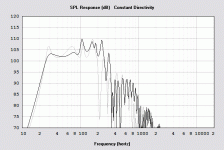
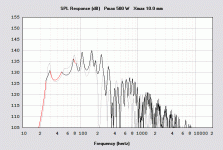
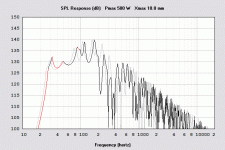
![Dayton PA385S-8 TH [mtnickel] rev..gif](/community/data/attachments/373/373420-ff1da2a82a736ce18e397608a489cf78.jpg?hash=_x2iqCpzbO)
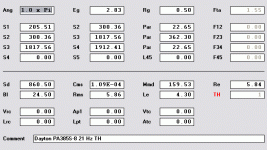
![Dayton PA385S-8 TH [mtnickel] rev. 2.gif](/community/data/attachments/373/373444-3f431a264dcf5f4bc79a97931f39329f.jpg?hash=P0MaJk3PX0)
